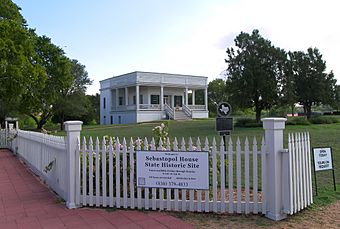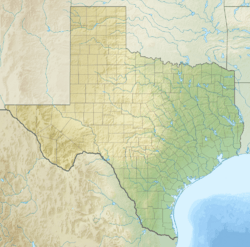Sebastopol House Historic Site facts for kids
The Sebastopol House Historic Site is a special house in Seguin, Texas, USA. It was built a long time ago, before the American Civil War, in a style called Greek Revival. What makes it really cool is that it's made entirely of concrete! Joshua W. Young built this unique house between 1854 and 1856 for his sister, Catherine LeGette.
Today, Sebastopol is one of about 20 old buildings in Seguin. This means Seguin has more early 1800s buildings than almost any other place in the United States! Because of its unusual concrete design, Sebastopol House was recognized as important in 1936. It became a Registered Texas Historical Landmark in 1964. Then, on August 25, 1970, it was added to the National Register of Historic Places. It's a great example of the special concrete buildings found in Seguin.
Contents
Building with Concrete
How Sebastopol House Was Built
Sebastopol House is one of the oldest and largest buildings in Texas made using a special concrete method. This method uses unreinforced concrete poured into molds. It's a very strong way to build!
This building process was invented and patented by a doctor and chemist named John Park. He moved to Seguin in 1846. Soon, other builders like Joshua Young started using his ideas. Workers would build wooden forms, keeping them 12 to 18 inches wide. Then, they would pour the concrete mixture into these forms. After the concrete hardened, the forms were moved up, and the process was repeated.
What Was in the Concrete?
A big part of "Park's concrete" mix was something called caliche. Caliche is a thick layer of gravelly clay found under the ground in Seguin. Often, the caliche was dug up right where the house was being built. This digging sometimes created a basement, like at Sebastopol House.
The caliche was then mixed with sand and lime. The lime came from nearby limestone. They also added natural materials like straw or horsehair to the mix. The outside walls were usually painted white. Inside, the houses often had beautiful wood details made from local walnut, oak, or pecan trees.
History of the House
The Zorn Family's Home
Joseph Zorn Jr. bought Sebastopol House in 1874. The house stayed in the Zorn family until 1961. Joseph Zorn Jr. was the mayor of Seguin from 1890 to 1910. He helped create the first free public schools in the town, which was a very important step for education.
Becoming a Historic Site
In 1976, the Texas Parks and Wildlife Department bought the house and its land. Before that, the Seguin Conservation Society had taken care of the house. They kept it safe until the state could get money to fix it up.
Sebastopol House opened to the public again in September 1989. The house was restored to look just like it did in the 1880s. In 2011, the City of Seguin took over ownership of the house. Today, it remains a fascinating place to visit and learn about history.
See also




